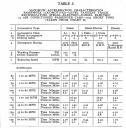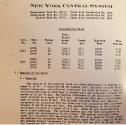
| Home | Open Account | Help | 254 users online |
|
Member Login
Discussion
Media SharingHostingLibrarySite Info |
Steam & Excursion > GS-4 Horsepower plus power of the atsf's 2900 seriesDate: 05/25/23 21:52 GS-4 Horsepower plus power of the atsf's 2900 series Author: ApproachCircuit There seems to be a few people out there that are disputing some HP ratings.
I got my information from official ESPEE publications: The 80 inch driver 4-8-4 put out 5500 HP at 55 mph. The earlier GS- 3's were good for 5000 HP at similar speeds. Talk to any old head SP passenger engineer and he will tell you it took four covered wagons to match the performance of. the GS-4/5's. To move 1500 tons of passenger equipment at 100mph takes about 6000HP. The NYC Niagra's and the Santa Fe northerns including the late 3780 class could do it. As a footnote, the later cab in front Baldwins put out 6000 Hp at 45mph. All from SP sources! If you want to dispute this send me your birthdate! I have a 60's date on the above railroads. Whats yours? Date: 05/26/23 03:46 Re: GS-4 Horsepower plus power of the atsf's 2900 series Author: feltonhill Unless the sources you cite spell out what kind of horsepower the figures represent, they are meaningless. On the other hand, we have to deal with the info we find. I believe you'll find that most of the "horsepower" figures you mentioned are Indicated HP, measured at the cylinders. Drawbar HP, measured at the rear of the tender, would be less. I'm pretty sure this is the case for the GS-3/4's. Moving a 1500 ton passenger train at 100 mph on tangent level track would require in the neighborhood of 4000 hp applied to the front coupler of the train, not 6000. I don't know what age has to do with anything, but I'm north of 70, if it matters
Date: 05/26/23 07:01 Re: GS-4 Horsepower plus power of the atsf's 2900 series Author: ApproachCircuit There is no way in hell two e-7s, 8's or 9's could reach 100mph with 1500 tons unless it was downhill. The HP per ton ratio of those 3 types was not good.
Take a look at many UP pictures of the C of LA and others having 5 or 6 e-units to make the schedule. The consist sometimes eguals one-third of the total train length! Call that HP efficiency? You want to really move? Try 800 HP per axle and then you have something! Date: 05/26/23 07:21 Re: GS-4 Horsepower plus power of the atsf's 2900 series Author: HotWater ApproachCircuit Wrote:
------------------------------------------------------- > There is no way in hell two e-7s, 8's or 9's could > reach 100mph with 1500 tons unless it was > downhill. The HP per ton ratio of those 3 types > was not good. Sure they could, on level track. Just like the NYC, PRR , IC and CB&Q did. > Take a look at many UP pictures of the C of LA and > others having 5 or 6 e-units to make the schedule. > The consist sometimes eguals one-third of the > total train length! That's because of the mountain grades they had to deal with and still maintain track speed. > Call that HP efficiency? > You want to really move? Try 800 HP per axle and > then you have something! Back in the 50s and 60s, which diesel passenger units had 800 HP per axle? The EMD E9 units had about 600 HP per four powered axles and they did fine. Date: 05/26/23 09:13 Re: GS-4 Horsepower plus power of the atsf's 2900 series Author: tomstp Yep, 562.5 per powered axel for a E-9. And, EMD would tell T&P they could run a train from Ft Worth to El Paso $1000 cheaper (per train) whether E or F units.
Edited 1 time(s). Last edit at 05/26/23 09:17 by tomstp. Date: 05/26/23 09:47 Re: Horsepower Author: timz > To move 1500 tons of passenger equipment
> at 100mph takes about 6000HP. The NYC > Niagara's and the Santa Fe northerns > including the late 3780 class could do it. NY Central never made any such claim. Neither did Santa Fe. > All from SP sources! An SP official did estimate that a GS did 5500 indicated HP when it maintained 55 mph on 1% with 900 tons. Maybe he was right. Aside from that, SP didn't publish much actual data. Date: 05/27/23 17:53 Re: Horsepower Author: wcamp1472 For stationary steam engines, used in factories, RPMs were very slow,
compared to 80" drivers locos --- doing 100-per. An 'indicator' was a drum-device used on slow speed, stationary steam engines ... to make power calculations ..... in such slow rpm engines indicator diagrams can be meaningful indicators of power produced . So, the wording 'indicated HP' means a number derived from the use of the spinning drum & paper of an Engine Indicator device. A pencil was held against a sheet of paper on the drum... the drum was connected to the piston ( by string) -- such that as the piston moved out and back to complete a stroke, the drum rotated about 220-degrees and back to Start. The drum rotated, back and forth as the piston moved, back and forth. The machine was designed to capture one drum stroke, and the pencil lifted, at the end of the manually triggered pencil-to-paper. So, during loco testing over the road, the instrument crew rode in an enclosed, small space at the very front of the loco, ahead of the smokebox front.... taking multiple indicator records ar varoius speeds... The slow-speed trace resembled a high-top sneaker's profile: the top ( ankle-hole) represented full boiler pressure, the laces-area down to the toe represented the declining steam pressure as the piston moved; the toe to the sole represented the opening of the exhaust valve, and the front sole-tip, back to the heel, was steam blown out...the open exhaust port. At the back, from the "heel" up to the "ankle-hole" repsented increasing admission pressure of boiler steam. The indicator, when manually triggered would hold the pencil against the drum, to make one complete trace, and the pencil was lifted, as the drum continued to rotate. back-and-forth. On Locomotives, travelling higher than about 10 to 15 mph the traces were squiggly lines. (angled about 45-degrees) barely separated cylinder-pressure from exhaust lines....there was NO accurate, recognizable "open trace" --- Power was supposed to be represented by the algebraic average of the 'open' ( pressured area) area of the enclosed-area trace of indicator record. Loco traces were impossible to measure accurately...the spinning drum, it's spring, and string could not keep up with the hundreds of driver RPMs... ( Today, for "indicator readings" you could easily capture accurate indicator diagrams using an oscilloscope in the test car, and electrical devices at the cylinders, as well a capturing actual temperture gradients during the length of the strokes. It's there that you could easily capture the degeee of superheat as exhausted steam went towards the stack..) So, there is NO reliable meaning to "HP measurements" labeled as " indicated horsepower". For locomotives, at speed, such claims are Total Bullsh**t. To be used for false advertising, only. A contrivance of James Watt; then he went into electricity... Do not make loco-to-loco comparisons, or assumptions, based on 'indicated horsepower'... it is an unspecified number, and cannot be used to make meaningful comparisons. W. Edited 6 time(s). Last edit at 05/28/23 09:31 by wcamp1472. Date: 11/15/23 16:29 Re: Horsepower Author: train1275 This may be of interest, from Paul W. Kiefer's Practical Evaluation of Motive Power, Page 55.
Kiefer was Chief Engineer Motive Power and Rolling Stock for the New York Central and the designer of the 4-8-4 Niagara Class and the poppet valve equivalent NYC 5500. Evaluation was based on a 1005 ton train, which needed 3 E7's to get up to 100mph. Note the acceleration of the Niagara vs. the Diesels up through the different speed ranges. Edited 1 time(s). Last edit at 11/15/23 16:31 by train1275.  Date: 11/15/23 17:40 Re: Horsepower Author: timz Those times/distances are calculated, not actual.
Note that when the 4-8-4 reaches 100 mph it hasn't quite caught up to the quicker-starting three-unit diesel. Edited 1 time(s). Last edit at 11/15/23 17:45 by timz. Date: 11/15/23 17:52 Re: Horsepower Author: HotWater timz Wrote:
------------------------------------------------------- > Those times/distances are calculated, not actual. How do you know THAT??? > Note that when the 4-8-4 reaches 100 mph it > hasn't quite caught up to the quicker-starting > three-unit diesel. Date: 11/15/23 17:55 Re: Horsepower Author: train1275 Actual test results taken near Utica, NY
I can't find the diesel tests, thought I had something somewhere.  Date: 11/15/23 18:09 Re: Horsepower Author: train1275 |